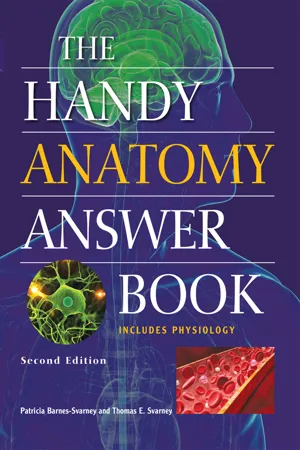
- 386 pages
- English
- ePUB (mobile friendly)
- Available on iOS & Android
The Handy Anatomy Answer Book
About This Book
Two established science writers and researchers distill and present the latest and most important information on anatomy and physiology in an easy-to-use, question-and-answer approach.
We all have one. The human body. But do we really know all of its parts and how they work? The Handy Anatomy Answer Book is the key to unlocking this door to a wondrous world. Learn how the body heals wounds. Untangle the mysteries of eyesight. Discover how cells organize themselves into organs and other tissues. From the violent battleground that is the immune system to the hundreds of miles of muscle fibers, nerves, veins, and arteries that fill our bodies, the human is a miracle waiting to be explored.
The Handy Anatomy Answer Book covers all the major body systems: integumentary (skin, hair, etc.), skeletal, muscular, nervous, sensory, endocrine, cardiovascular, lymphatic, respiratory, digestive, urinary, and reproductive, and, for good measure, adds chapters on growth and development and how science can help and augment the body. It follows the fascinating maze of organ systems and shows how much the body does routinely just to let you move, breathe, eat, and fight off disease. Fascinating trivia, along with serious facts, combine to answer over 1, 200 questions about the human body, including …
- Who were Hippocrates and Galen?
- What is Gray's Anatomy?
- Do all animals need oxygen?
- What are the largest, smallest, and longest cells in the human body?
- What is the average lifespan of various cells in the human body?
- Does exercise increase the number of muscle cells?
- What is phantom limb pain?
- Should ear wax be removed?
- What does it mean to have 20/20 vision?
- Do identical twins have the same fingerprints?
- Do the hair and nails continue to grow after death?
- How strong is bone?
- Which is the only bone that does not touch another bone?
- What does it mean when someone is "double-jointed"?
- How many muscles does it take to produce a smile versus a frown?
- What are tendons?
- What is Botox?
- What is the effect of aging on the muscular system?
- What are the functions of the nervous system?
- What are the causes of epilepsy?
- How large is the brain?
- What is a concussion?
- What are the seven warning signs of Alzheimer's disease?
- What is a reflex?
- How much sleep does an individual need?
- How are hormones classified?
- What is the difference between Type I and Type II diabetes?
- Do males have estrogen and females have testosterone in their respective systems?
- Why is blood sticky?
- How does exercise affect the heart?
- Why does blood in the veins look blue?
- What is an autoimmune disease?
- What are "swollen glands"?
- Why is it difficult to treat viral infections with medications?
- What was the earliest known vaccination?
- What's the difference between an intolerance and an allergy?
- What is the Adam's apple?
- Why is it more difficult to breathe at high altitudes?
- How much force does a human bite generate?
- Does the stomach have a memory?
- What is "gluten intolerance"?
- What are the causes of obesity?
- What percent of a person's intake of water comes from drinking water?
- Is urine always yellow in color?
- What are the phases of the reproductive cycle?
- How do the terms zygote, embryo, and fetus differ?
- How does fetal blood differ form adult blood?
- How are PET scans used to detect and treat cancer?
- When was the first successful pacemaker invented?
- What is an artificial joint?
- Can humans use organs from other animals for transplants?
A glossary and index are included, along with nearly 120 color illustrations, detailed medical charts and photographs help supplement the text. This handy reference helps make the language of anatomy—as well as physiology and pathology—more understandable and less intimidating. The Handy Anatomy Answer Book is an engaging look at the topic, the historic development of the science, the personalities behind the research, and the latest controversies and scientific advancements.
Frequently asked questions
Information
Table of contents
- Front Cover
- Title Page
- Contents
- Acknowledgements
- Photo Sources
- Introduction
- History of Anatomy
- Anatomy and Biolxsogy Basics
- Levels of Organization
- Sensory System
- Integum Entary System
- Skeletal System
- Muscular System
- Nervous System
- Endocrine System
- Cardiovascular System
- Lymphatic System
- Respiratory System
- Digestive System
- Urinary System
- Reproductive System
- Human Growth and Development
- Helping Human Anatomy
- Further Reading
- Glossary
- Index
- Copyright